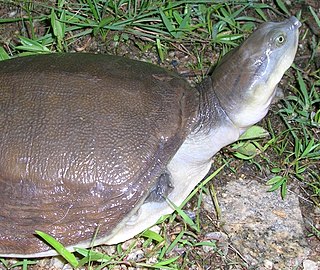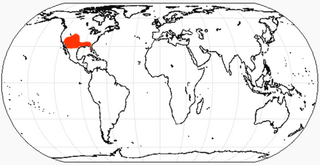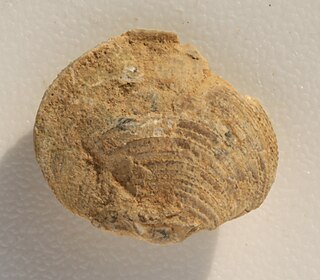
Equidae is the taxonomic family of horses and related animals, including the extant horses, asses, and zebras, and many other species known only from fossils. The family evolved around 50 million years ago from a small, multi-toed ungulate into larger, single-toed animals. All extant species are in the genus Equus, which originated in North America. Equidae belongs to the order Perissodactyla, which includes the extant tapirs and rhinoceros, and several extinct families.
Physeter is a genus of toothed whales. There is only one living species in this genus: the sperm whale. Some extremely poorly known fossil species have also been assigned to the same genus including Physeter antiquus from the Pliocene of France, and Physeter vetus from the Quaternary of the U.S. state of Georgia. Physeter vetus is very likely an invalid species, as the few teeth that were used to identify this species appear to be identical to those of another toothed whale, Orycterocetus quadratidens. The name is from Greek φυσητήρ (physētēr) 'blowpipe, blowhole .'
Dinodocus is a genus of sauropod dinosaur, named by Richard Owen in 1884. The name is now usually considered a nomen dubium. The only species, D. mackesoni, a name given to some fossil bones from the Lower Greensand Group of Hythe, Kent, England, were formerly placed in the genus Pelorosaurus, but a review by Upchurch et al. (2004) concluded that Dinodocus is a nomen dubium.

Lissemys is a genus of softshell turtles in the subfamily Cyclanorbinae of the family Trionychidae. The genus is indigenous to southern Asia.

Cycloderma is a genus of softshell turtles in the subfamily Cyclanorbinae of the family Trionychidae. The genus is endemic to Africa.

Carpocyon is an extinct genus of the Borophaginae subfamily of canids native to North America. It lived from the Middle to the Late Miocene, 13.6 to 5.3 Ma Mya, existing for approximately 16.5 million years. The four species in the genus varied in size, with the largest being about the size of a wolf; all had relatively small teeth, suggesting a diet that was more omnivorous than that of other contemporary borophagines.

Homalonotus is an extinct genus of trilobites in the order Phacopida. It contains several species, including H. armatus and H. roemeri. It is closely related to other trilobites such as Arduennella and Dipleura..

Barrosasaurus is a genus of titanosaurian sauropod dinosaur, first described by paleontologists Leonardo Salgado and Rodolfo Coria in 2009. The fossils, consisting of three fossil dorsal (back) vertebrae, are well-preserved but incomplete. They were discovered in the Anacleto Formation of the Neuquén province of western Argentina. The type species is Barrosasaurus casamiquelai. The genus name is named after the Sierra Barrosa in Neuquén. The specific epithet honours the Argentinian paleontologist Rodolfo Magín Casamiquela. It's been estimated to be 18 meters in length and 13.5 tonnes in weight.

Composita is an extinct brachiopod genus that lived from the Late Devonian to the Late Permian. Composita had a cosmopolitan global distribution, having lived on every continent except Antarctica. Composita had a smooth shell with a more or less distinct fold and sulcus and a round opening for the pedicle on the pedicle valve. Composita is included in the family Athyrididae and placed in the subfamily Spirigerellinae.

Plagiostoma is a genus of fossil saltwater clams, marine bivalve mollusks in the family Limidae, the file clams.

Trigonotretidae is an extinct family of articulate brachiopods belonging to the order Spiriferida.

The Word Formation is a geologic formation in Texas. It preserves fossils dating back to the Permian period. It is probably named for the Old Word Ranch in the Glass Mountains of Brewster County.

Leptadapis is a genus of adapiform primate that lived in Europe during the middle Eocene. Fossils of the genus have been found in the Escanilla Formation of Spain and Egerkingen in Switzerland.

Cleiothyridina is an extinct genus of brachiopods.

Boreostemma is an extinct genus of glyptodonts from northern South America. Fossils assigned to the genus were first described as belonging to Asterostemma from southern South America, but have been placed in the new genus Boreostemma by Carlini et al. in 2008. The type species is B. pliocena. Fossils of Boreostemma have been found in the Honda Group of Colombia, in Peru and Venezuela.

Miocochilius is an extinct genus of small notoungulate mammals (typotheres) native to South America. The genus lived during the Middle Miocene epoch. The genus contains two described species, the type species M. anomopodus described in 1953 by Ruben Arthur Stirton and M. federicoi, described and included in the genus by Darin A. Croft.

Rafinesquina is an extinct genus of large brachiopod that existed from the Darriwilian to the Ludlow epoch.
Bairdemys is an extinct genus of side-necked turtles in the family Podocnemididae. The genus existed from the Late Oligocene to Late Miocene and its fossils have been found in South Carolina, Puerto Rico, Panama and Venezuela. The genus was described in 2002 by Gaffney & Wood and the type species is B. hartsteini.
Beecheria is an extinct genus of brachiopod belonging to the order Terebratulida and family Beecheriidae. Fossils of this genus have been found in Mississippian to Permian beds in Eurasia, Australia, North America, and South America. The genus was part of the Levipustula fauna characteristic of cold water conditions. "Nests" of Beecheria have been found in fossil low temperature hydrothermal vent communities from the early Carboniferous in Newfoundland.















